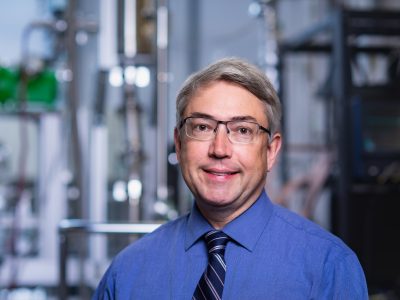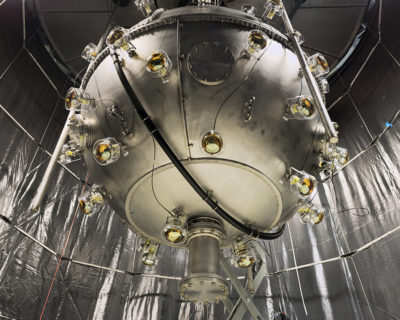
Ellen Tsaprailis, January 31, 2022
Photo credit: Luther Caverly and Lindsay Ralph
Experiment at SNOLAB Achieves World-Leading Result in the Search for Dark Matter
The search for dark matter saw a new development with the latest results from the DEAP-3600 experiment at SNOLAB—a world-class science facility deep underground at Vale’s Creighton nickel mine in Sudbury, Ontario.
Carleton University researchers—as members of a multinational collaboration of 100 scientists across 25 different institutions in nine countries—looked for dark matter particles up to the Planck mass. At 22 micrograms, the Planck mass is about the mass of a grain of sand and the greatest mass an elementary particle could have.
In data collected since 2016 with DEAP-3600, no telltale sign of such a particle was found in the detector. For the first time, researchers were able to rule out the existence of dark matter particles over a very wide range of values in mass and interaction strength. This is the first direct detection constraint on Planck-scale mass dark matter particles.

“We were the first ever to be able to look for particles at this level and have shown that they don’t make up dark matter,” says Mark Boulay, Canada Research Chair in Particle Astrophysics and Subatomic Physics. “After a careful three-year search, we can rule it out.
“It’s certainly exciting to be part of the first experiment to have sensitivity at this mass scale.”

The results from this extensive search, that were published on January 5, 2022 in Physical Review Letters, rule out multiple theoretical possibilities for what dark matter could be.
“We have a great deal of evidence that dark matter exists, but we don’t know what it is. Scientists looking for dark matter are like explorers. It is exciting to chart new territory in the theoretical landscape,” says Simon Viel, Assistant Professor in the Department of Physics and the Analysis Coordinator for DEAP-3600.

The DEAP-3600 experiment uses 3.3 tonnes of liquid argon at a temperature of about ‑180 Celsius. This argon is at the core of attempting to detect an invisible substance known as dark matter, which is thought to account for roughly one-quarter of the universe’s energy density. This ever-present but mysterious substance acted as a catalyst in the formation and evolution of galaxies such as our Milky Way. Dark matter could be composed of particles that do not absorb, reflect or emit light and therefore cannot be seen directly with our eyes, but may be detectable via rare interactions with ultra-sensitive particle detectors.

Housed at SNOLAB, the DEAP-3600 experiment gathered data from 2016 to 2020, looking to observe dark matter interactions with the liquid argon. As the largest-size dark matter detector, DEAP-3600 is the only means through which such spectacular sensitivity could be achieved.
The search for dark matter continues but Boulay says that we now have one more piece of the puzzle. “Though DEAP-3600 had no detection, we’ve now ruled out a new set of models that predict these super-heavy particles, which helps to narrow down the search,” says Boulay.
“It’s a work in progress. We are looking for dark matter and so far finding out what it isn’t. There are lots of theories and models about what dark matter can be. There were models predicting that it could be super-heavy, massive particles and many of those models we’ve now ruled out with this result. The effort will continue.”

Carleton Researchers Searching for Dark Matter
In addition to Boulay who leads the DEAP-3600 experiment and Viel who co-ordinates the analysis of DEAP-3600 data, the analysis team at Carleton includes Professor Kevin Graham and Distinguished Research Professor David Sinclair. The other Canadian research institutions participating in DEAP-3600 are the University of Alberta, Canadian Nuclear Laboratories, Laurentian University, Queen’s University, SNOLAB and TRIUMF. Scientists at INFN Cagliari, Italy, played a leading role in this Planck-scale mass dark matter search analysis.
The ongoing DEAP-3600 experiment is currently undergoing upgrades and the team will operate it for another couple of years with even better sensitivity to dark matter. Looking to the future, DEAP-3600 collaboration members are part of the longer-term program to detect dark matter with liquid argon. The next experiment, DarkSide-20k, will be more than 10 times larger than DEAP-3600, and then a final detector named ARGO will be 100 times larger than DEAP-3600. The international goal remains to find dark matter particle interactions in the next 20 to 30 years.
Share: Twitter, Facebook